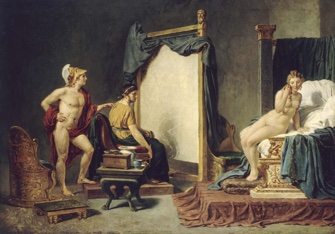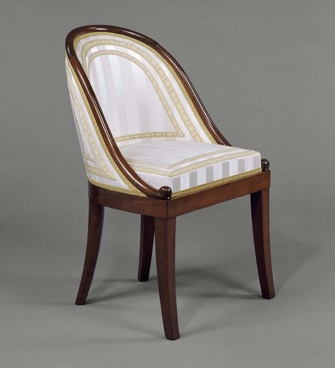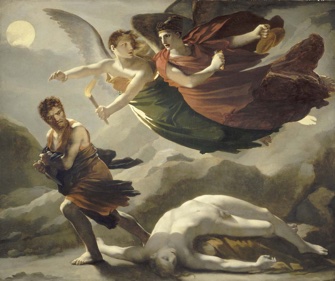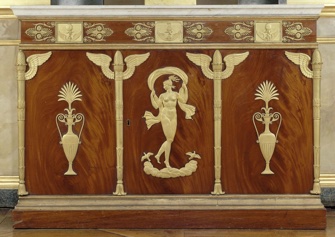The Emperor’s
Not-so-New Furniture

“Apelle Peignant Campaspe en Présence d’Alexandre” (c. 1812), by Jacques Louis David. © Rmn-Grand Palais/Philipp Bernard
Was Napoleon, on top of his many other attributes, a style-setter? Not really, according to the exhibition “Napoléon Ier ou la Légende des Arts,” currently on show at the Musée National du Palais de Compiègne. Although the Empire style conquered France and most of Europe in the early 19th century, it was more a case of the revival, continuation and development of trends that had their roots in the Ancien Régime, before royal and aristocratic heads began rolling during the Revolution.
Antiquity had already been all the rage in the Louis XVI decorative universe, and since many of the same artisans continued to work from one regime to the next, stylistic tendencies naturally carried over. One example is an expanse of satin embroidered with flowers and birds that was intended for the salon of Empress Marie-Louise at Versailles, made by Marie-Antoinette’s embroiderer. Another piece, an elaborate “Arabic” porcelain coffee pot, was made in 1806 but decorated with 18th-century cornflower and ribbon motifs. While Napoleon may not have dictated style, he wanted the best of everything, and the best artisans were those who had supplied his royal predecessors.
Emphasizing the recurrence of trends, the exhibition, which includes nearly 200 pieces, many of which have never before been exhibited, shows how even a century later the Empire style was once again à la mode, with the side-by-side display of strikingly similar “Gondola” chairs, one made by François-Honoré-Georges Jacob-Desmalter around

Gondola chair (c. 1808), by François-Honoré-Georges Jacob-Desmalter. © Rmn-Grand Palais (Domaine de Compiègne)/All rights reserved
1811 and another by Jacques-Emile Ruhlman c. 1925. Variations on this style are, by the way, once again popular today.
Another antique influence covered by the show is that of Egypt, which became important as a result of Napoleon’s Egyptian campaign (1798-1801), apparent in the abundance of sphinxes and representation of Egyptian gods and goddesses in the decorative arts.
The second part of the show goes back to the Consulate and the influence of Napoleon’s favored architects, Charles Percier and Pierre-François-Léonard Fontaine, who decorated many of the apartments in Paris’s new Chaussée d’Antin quarter, which was popular with the nouveaux riches of the early 19th century. The imposing, massive neoclassical Consulate style, which later gave way to the more majestic Empire style, favored the use of mahogany with bronze fittings for furniture. Women artists, among them Constance Charpentier, represented by her painting “Melancholy” (1801), were on the rise during this period.
As the exhibition ends, we see the decorative arts moving away from the neoclassical style and toward the medieval and Gothic influences

“La Justice et la Vengeance Divine Poursuivant le Crime,” a pre-Romantic painting by Pierre-Paul Prud’hon © Rmn-Grand Palais/Daniel Arnaudet
presaging Romanticism, which would come into full bloom under the Restoration.
After the exhibition, make sure you visit the rest of the Compiègne Palace, home to the largest Empire apartments in France, making it the perfect setting for this show. The bedroom of Napoleon’s son, the King of Rome (formerly Marie-Antoinette’s bedroom) is a fine example, with its rich blue décor. Napoleons’s magnificent library (now lined with books donated by Tsar Nicholas II in 1901) is a must with its handsome mechanical

A commode decorated with the figure of Venus, from the empress’s bedroom at Compiègne, by François-Honoré-Georges Jacob-Desmalter. © Rmn-Grand Palais (Domaine de Compiègne)/Daniel Arnaudet
desk containing secret drawers for important documents, made by Jacob-Desmalter. The room itself has a secret book-covered door leading to the Empress’s room.
Compiègne is a great destination that is strangely neglected by visitors, especially considering that it is less than an hour from Paris and is easy to get to by train. Do pay a visit, not only to see this instructive exhibition full of handsome period pieces but also to visit the château, built by Louis XV and Louis XVI and renovated under Napoleon I and Napoléon III. A rather fine tea room and restaurant (open Wednesday to Monday, 11am-5pm) with a garden terrace was recently opened in an outbuilding in the large park.
The city, next to a large forest, itself merits a visit. During its two millennia of history, it witnessed the crowning of Odo as King of the Franks in 888, Joan of Arc’s capture by the Burgundians, Marie de’ Medici’s exile by her son, the signing of the armistice ending World War I and the establishment of an internment camp by the Nazis (memorials commemorate the latter two events).
The city also boasts an ornate 16th-century town hall with a bell tower, Napoleon III’s Imperial Theatre, a 12th-century tower named after Joan of Arc, half-timbered houses and many other historic vestiges. In other words, a must for anyone interested in the history of France and its culture. It is also home to the Musée National de la Voiture et du Tourisme, with a collection of carriages from the 17th to 20th centuries as well as automobiles and motorcycles. It’s a mystery why it’s not on the tourist circuit.
Click here for a review of an exhibition on a little-known aspect of Napoleon’s career.
Musée National du Palais de Compiègne: Place du Général de Gaulle, 60200 Compiègne. Train from Paris Gare du Nord, 40 minutes. Tel: 03 44 38 47 00. Open 10am-6pm. Closed Tuesday. Admission: €9.50 Through July 27. www.musees-palaisdecompiegne.fr
Reader reaction: Click here to respond to this article (your response may be published on this page and is subject to editing).
Please support Paris Update by ordering books from Paris Update’s Amazon store at no extra cost. Click on your preferred Amazon location: U.K., France, U.S.
More reviews of Paris art shows.
© 2015 Paris Update
Favorite